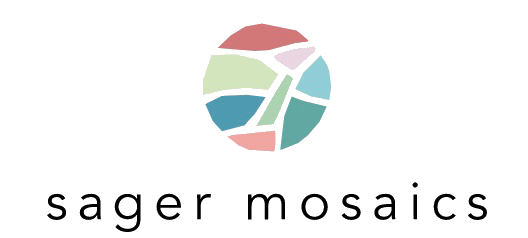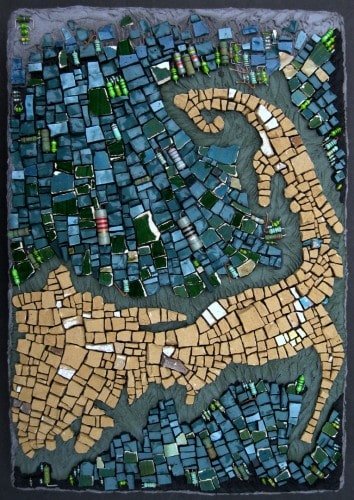Can the line make you a better person?
“The Cape of Cod” (2013)
What’s the big deal about this word that we mosaicists seem to endlessly obsess over? Andamento. Look it up and you will find lots of oblique definitions that lead you to other, similarly muddy descriptions. Pathways, courses, movement, flow. Some very complex musical terms that fall short in conveying this intimate act of building a line with pieces of things. None of them really hit the nail on the head for me. They lack a descriptiveness that is crucial for this very specialized language that I speak. Conversations about the line with like-minded artists animate me more than politics or the newest iPhone or food trucks.
Simply put: the line fires me up.
Give me the cube-like shape and interstices and the inherent superiority of a vertically placed rectangle over one placed horizontally. Watch my eyes light up when someone says the word sdoppiamento. I have steeped myself in the value of the line. I believe, in my medium, it matters more than color, texture, or composition. The line is supreme.
Patricia Thomas @ The Ruins
In the beginning, I was consumed with answering the unanswerable question: how many different kinds of andamento are there? I was fortunate enough to be sitting with Maestro Verdiano Marzi when I asked this question and, more to the point, was ready to hear his answer: “There are as many andamenti, Rachelle, as there are artists to create them.” I can transport myself back to that moment, at will, to re-live the relief and exhilaration.
Verdiano Marzi
I call it an unanswerable question because there is no limit to what a mosaicist can express with her lines. Her lines are her. If you are doing it right, your lines become an extension of your personality, your philosophy, dare I say it? Yes, I do…your soul. If you accept my argument that your lines can reflect a part of your soul, you must also accept that your lines must be unique in the world. Hence, there are as many andamenti as there are artists to create them.
Rachel Sager @ The Ruins
Rachel Sager @ The Ruins
But, how does one get to this mysterious place of building lines that express those deepest parts of what make us tick? The pool of contemporary artists working in this medium today and successfully building lines that are uniquely their very own is small.
Jo Braun
I will admit, with some trepidation, that once I learned the rules, my lines began to flow from me like a river. After the initial awkwardness of the first year, building lines became second nature. And after that, the act became enjoyable to the point of contentment. I choose the word contentment over, say, euphoria because feeling content is a more fleeting, slippery experience than most any other emotion. In life, I lean towards anxiety and worry. When I am building lines my brain switches to another frequency. I experience a peace that is missing in my other life. When I look for that next square of stone, there are no doubts and no second guessing. I am sure of my choice. And then I am sure of my next choice. I choose with confidence whether to set a keystone, a cube-like shape, a sliver, a rectangle, a circle, or even a triangle. I choose, mostly on an intuitive level, how to angle the shape of stone or glass into its bed of thinset. One way of describing this phenomena is that I put the best of myself into my lines every day. My glaring imperfections in life contrast to the little bits of perfection that I can build onto the substrate. The line makes me a better person.
“Allegory of Free Will” (2011) Private Collection of Ashley Judd
I have often spoken of the difference between the kind of andamento that one uses as a tool to get you from point A to point B and andamento for the sake of itself. The mosaicists who came before us built an impressive infrastructure of rules (guidelines) that enabled them to tell their stories. When we see the Greek, Roman, and Byzantine mosaic work, we are looking at centuries of cultural knowledge that evolved specifically to perfect the image. Whether that image is the human form, a rabbit, or a mountain landscape, the elegant line made them all come alive. It was a means to an end. I call that point A to point B andamento. When I am being critical, I sometimes call it filling in the space andamento, although I usually reserve that term for poorly executed work and not the wonderful classical examples.
So, how would I define the other kind, the andamento for the sake of itself? That’s a longer conversation. I see them as pathways of expression. The line builder is expressing herself within the line. She may be working in the confines of some boundaries but those are secondary to her total immersion in building lines that stand on their own; lines that speak for themselves. Nothing makes me happier than making all those hundreds and thousands of choices, knowing that with each one I am all at once expressing actions that are deeply intimate and universally common. Those of us working in these decades of the creator mosaicist (credit again to Maestro Marzi for his beautiful phrase) have inherited valuable knowledge from the past, but we are unburdened by the dogma and tradition that can sometimes work to stifle creativity. We have the luxury of freedom that the contemporary art world values so much. We can choose to make up our own odd little rules that help us to innovate new lines. These are heady, singular times we creator mosaicists live in.
Anabella Wewer
We can compare line building to architecture. Creating little communities of tesserae that can theoretically be never-ending cities of communication. From a single tessera house to a collection of tesserae villages, onward towards cityscapes, patchwork fields, layered landscapes, or even global swaths of expression. Some mosaicists compare the line to writing. One word builds on the next. Each word should work to make the one before and after it stronger, or if not stronger, then at least more interesting. Every word (tessera) matters to the overall story (composition).
Julie Sperling
I watch students struggle with all those choices. When you invite the fear into your lines, you will be faced with a dreaded, creeping doubt that moves you away from the divine pursuit of what it’s all about: the miracle of that repetitive freedom of choice. If I were speaking to a student now, I would say, “Don’t let the line smell your fear. Like a horse, you must come to it with a calm mind and a confident hand.” Today, as I struggle through the doubts and fears of an imperfect life, I am consoled with the knowledge that the line is out there, waiting for me to return.
Sign up for the newsletter
You will receive one or two high quality blogs a month about anything from the state of contemporary mosaic, the power of dreams, the art of foraging to the latest updates on The Ruins.









